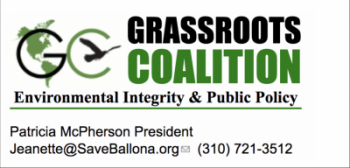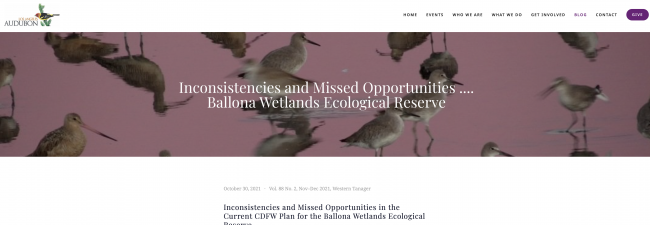Submitted on

To: Andrew Willis, California Coastal Commissioners, and Coastal Commission Staff,
The following presentation pertains to Ballona Wetlands and its Sustainable Groundwater Management aspects as a Groundwater Dependent Ecosystem. A presentation to the Groundwater Sustainability Agencies of the Santa Monica Subbasin leads the additional discussion with new information from Grassroots Coalition and Margot Griswold,PhD, a renown California restoration ecologist with over 27 years of expertise and engagement in positive habitat outcomes including the interagency, highly contentious Owens Valley Dust Control Plan via habitat restoration. Owens Valley became a consensus planning model that now exists and can be utilized for the restoration of Ballona Wetlands Ecological Reserve.
Key points in the presentation include:
1. The Groundwater Sustainability Plan Final Draft addresses in Appendix F, the data gap that exists which demonstrates that it is not possible, at present to address potential saltwater intrusion issues in the lower Santa Monica Subbasin due to a lack of needed monitoring wells. Neither sea level rise nor the California Dept. of Fish & Wildlife's (CDFW) proposed removal of over 3 million cubic yards of soil has been modeled to determine if CDFW's Plan for lowering the Ballona Wetlands below sea level for creation of a new saltwater bay, will have impacts of saltwater contamination to the Silverado Aquifer or the upper freshwater aquifers currently classified by the Water Board as Drinking Water and Potential Drinking Water respectively.
The CDFW Final Environmental Impact Report does not include hydrologic evaluation of Ballona itself and does not address the potential negative impacts upon the aquifers and/or the potential impacts upon Ballona Wetlands as a freshwater/ Groundwater Dependent Ecosystem.
2. The Groundwater Sustainability Plan does not yet include data of the Playa Vista ongoing dewatering needed for the Clean Up and Abatement Order 98-125 (for the Howard Hughes/ MacDonald Douglas Aircraft decontamination) or the Playa Vista dewatering for the gas mitigation systems of the Playa Vista Methane Prevention Detection and Monitoring Program (Playa Vista Phase 1 Methane Code) or the Citywide Methane Code dewatering on the Phase 2 area of Playa Vista. No information exists in the GSP per the 20 years of dewatering via the unpermitted drainage wells in the wetlands that the California Coastal Commission cited as a violation of the Coastal Act as harming the hydrology and ecology of Ballona. Essentially, as in many GSPs an adequate evaluation of a Groundwater Dependent Ecosystem has not been done for Ballona Wetlands/ Ballona Wetlands Ecological Reserve.
3. New information regarding the legally required protective laws for Ballona (Title 14, Section 630 Terrestrial/ NonMarine Ecological Reserve status that is Ballona specific) have not had adherence by the California Coastal Conservancy in its oversight and control of the Ballona Environmental Impact Report studies and documents.
The Coastal Conservancy in 2005, narrowed the scope of review by the Southern California Coastal Wetland Research Program and the Science Advisory Committee to a preferred alternative--estuarine, marine goal that was and is inconsistent with the Title 14, Section 630 Terrestrial/ Non Marine Ecological Reserve status that was approved by the Ca. Fish & Game Commission and Registered with the Office of Administrative Law.
(SCCWRP Letter--Slides 28,29 of 31)
The following website link includes the Audubon article by Dr. Griswold, which contains new information regarding Ballona Wetlands Ecological Reserve status as an Ecological Reserve including the Office of Administrative Law's Registration as a terrestrial/ NONMARINE Ecological Reserve with its own specific Purpose and Goals for its acquisition.
Additionally,
Fish & Game Code 1745
1745. (a) For purposes of this section, the following terms have the following meanings: (1) “Department-managed lands” includes lands, or lands and water, acquired for public shooting grounds, state marine (estuarine) recreational management areas, ecological reserves, and wildlife management areas.
(2) The department may enter into contracts or other agreements for the management and operation of department-managed lands with nonprofit conservation groups, recognized under Section 501(c) of the Internal Revenue Code, or resource conservation districts, as described in Chapter 3 (commencing with Section 9151) of Division 9 of the Public Resources Code.
(B) The contracts or other agreements authorized pursuant to this paragraph shall adhere to the goals and objectives included in an approved management plan and shall be consistent with the purpose for which the lands were acquired and managed by the department. Any changes to the management plan shall be subject to public review and comment.
The Goals and Objectives for which the Ballona Wetlands Ecological Reserve was acquired with public funds, over $140 million, are as follows:
California Regulatory Notice Register 2005, Volume No. 20-Z, Starting on page 663 Ballona Wetlands Ecological Reserve
The Fish & Game Code 1745, above, provides also for adherence to the Title 14, Section 630 status approved for Ballona Wetlands Ecological Reserve and it follows that any/all agreements and actions should abide by the Registered Purpose and Goals. Ecological Reserves require, under Fish and Game Code 1019, that a Land Management Plan (LMP) be prepared for the Reserve after acquisition. The LMP leading language begins with the Purpose and Goals of the (Section 630) acquisition in it requirements for study. Any/all subsequent Environmental Impact Reports for the Ecological Reserve also start with the same premise.
No Land Management Plan was performed for Ballona Wetlands Ecological Reserve and the language of the Title 14, Section 630 Terrestrial/ NONMARINE with specific Ballona Wetlands Purpose and Goals language was not the premise of the Environmental Impact Report controlled and prepared by the California Coastal Conservancy (a Responsible Agency). Instead, the Coastal Conservancy utilized an inconsistent premise of preferred alternative of 'restoring the ebb and flow of the ocean' in its inconsistent narrowing of alternatives
for Ballona's restoration in both its contract language to the Southern California Coastal Waters Research Program/ SAC and in the premise of the Environmental Impact Report.
We believe that the California Coastal Conservancy failed to adhere to Title 14, Section 630 terrestrial/nonmarine Ecological Reserve status for Ballona Wetlands Ecological Reserve and failed to abide by and advise CDFW, in its legal role as an advisory Responsible Agency, and failed to abide by Fish & Game Code 1745.
Please review the materials provided herein and keep this information as necessary information in the consideration by the California Coastal Commission for any/all decision making for Ballona Wetlands Ecological Reserve--restoration.
Thank you,
Patricia McPherson, Grassroots Coalition
News Article or New Content:
- 2203 reads


